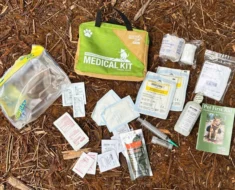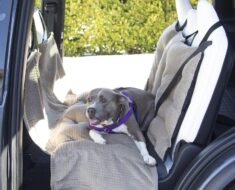Bringing a new puppy into your home is exciting, but introducing them to your older dog can feel tricky. You want both dogs to feel safe and happy from day one.
If you handle the first week the right way, you can help your pets build a strong bond instead of tension. This guide will show you simple, effective steps to make that introduction smooth and stress-free. Keep reading to discover how to create a peaceful and loving environment for your furry family members.
Preparing Your Home
Preparing your home helps your older dog and new puppy adjust well. It makes their first days calm and safe. Setting up the right environment lowers stress for both dogs. It also helps you manage their needs easily.
Start by organizing spaces and gathering all important items. Create areas where each dog feels comfortable. Think about places where they can rest and play without trouble.
Create Separate Spaces
Give each dog its own space at home. Use baby gates or doors to keep areas apart. This helps avoid fights and gives dogs a break from each other. Older dogs need quiet spots to relax. Puppies need a safe place to explore and sleep.
Gather Essential Supplies
Collect supplies for both dogs before the puppy arrives. Have two sets of food and water bowls. Use separate beds and toys for each dog. Keep leashes and collars ready. These items prevent fights over resources. They also help build good habits early.
Set Up Safe Zones
Designate safe zones where each dog can feel secure. These spots should be away from noise and traffic. Add comfy bedding and favorite toys there. Safe zones help reduce anxiety and give dogs space to calm down. Both dogs need places to retreat if they feel overwhelmed.
Initial Introduction
Introducing a new puppy to an older dog needs care and calm. The first meeting sets the tone for their relationship. Take small steps to help both dogs feel safe and relaxed. Watch their actions closely and act gently.
Choose Neutral Territory
Pick a place that belongs to neither dog. A park or a quiet street works well. This stops the older dog from feeling like it must protect its home. Neutral ground helps both dogs meet without stress. It makes their first interaction fair and calm.
Keep Both Dogs Leashed
Use leashes to keep control and safety. Leashes allow you to stop any sudden moves. Keep the leashes loose to avoid tension. Tight leashes can make dogs feel nervous or aggressive. Let them walk and sniff each other slowly.
Observe Body Language
Look for signs of comfort or stress. A wagging tail often means happiness. Raised hackles or growling show discomfort. Ears back or avoiding eye contact means fear. If either dog looks upset, pause the meeting. Give them time to relax and try again later.
Supervised Interactions
Introducing a new puppy to an older dog needs care and patience. Supervised interactions help both dogs feel safe and calm. These moments build trust and good habits early on. Watch closely and guide each meeting to keep peace.
Short, Positive Meetings
Keep the first meetings brief. A few minutes is enough to start. End on a good note before either dog gets tired or upset. Short sessions prevent stress and help dogs enjoy each other’s company.
Use Treats And Praise
Treats make meetings more pleasant. Give both dogs small snacks during the interaction. Praise them with kind words and gentle petting. This rewards good behavior and encourages calmness.
Watch For Stress Signs
Look for signs like growling, stiff bodies, or avoiding eye contact. These show discomfort or stress. Stop the meeting if you see these signs. Let the dogs rest before trying again.

Credit: www.youtube.com
Managing Resources
Managing resources is key to a smooth introduction between your new puppy and older dog. Sharing can cause stress and fights. Dogs feel safer when they have their own space and things.
Providing clear boundaries helps both dogs adjust. It reduces jealousy and competition. This makes the first week easier for everyone.
Separate Feeding Areas
Feed your dogs in different spots. This stops food guarding and growling. Use separate bowls and keep some distance. This simple step keeps mealtime calm and stress-free.
Individual Toys And Beds
Give each dog their own toys and bed. Sharing toys can cause fights or anxiety. Separate beds help each dog feel safe. This space is important for rest and comfort.
Avoid Competition
Do not force your dogs to share resources. Watch for signs of tension or guarding. Praise calm behavior and keep things fair. Avoiding competition helps build trust and peace.
Establishing Routine
Establishing a routine is important when introducing a new puppy to an older dog. It helps both dogs feel safe and understand what to expect each day. A steady schedule reduces stress and builds trust between them. Consistency brings calm and makes the adjustment smoother for everyone.
Consistent Feeding Times
Feed both dogs at the same times every day. This prevents competition and helps them settle into a pattern. Use separate bowls and places to avoid fights. Watch for signs of stress during meals. Stick to the same food type and amount for each dog.
Regular Exercise Sessions
Take the dogs for walks or play outside at set times. Exercise burns off energy and lowers tension. Let the older dog get used to the new puppy’s pace. Short, frequent walks work well at first. Keep both dogs on leashes until they are comfortable together.
Scheduled Playtime Together
Plan times when both dogs can play safely. Choose calm, gentle games to avoid roughness. Watch their body language closely. End playtime before any signs of stress appear. Gradually increase playtime as they grow more comfortable.
Addressing Behavioral Issues
Introducing a new puppy to an older dog can bring some challenges. Behavioral issues may arise during the first week. Recognizing and managing these behaviors early helps both dogs feel safe and comfortable. Staying calm and patient is key. Let’s explore ways to address common problems.
Redirecting Aggression
Aggression may show as growling, snapping, or stiff body language. Do not punish the dogs. Instead, gently interrupt the behavior. Use a toy or treat to shift their attention. Give each dog space to calm down. Keep interactions short and positive. Reward peaceful behavior to encourage good habits.
Encouraging Calm Behavior
Create a quiet environment for both dogs. Offer separate resting spots to reduce tension. Praise calmness with soft words and treats. Avoid loud noises or sudden movements. Regular walks help burn energy and reduce stress. Calm dogs build trust and a better bond.
When To Seek Professional Help
Sometimes, behavioral issues may be hard to manage. If aggression increases or does not improve, seek help. A professional trainer or behaviorist can guide you. Early support prevents problems from worsening. Getting help shows care for your dogs’ well-being.
Building Long-term Bond
Building a strong bond between your new puppy and older dog is key for peace at home. This bond helps them feel safe and happy together. It takes care, time, and smart steps to grow their friendship. Focus on small moments and good experiences. These build trust and love that last for years.
Positive Reinforcement
Use treats and praise to reward good behavior. Give both dogs a treat when they stay calm near each other. Praise them with a soft voice and gentle petting. This teaches dogs that being together means good things. Avoid punishment, as it can make fear and tension worse. Keep rewards simple and frequent to build trust fast.
Shared Activities
Do fun things together like walks or playtime. Let your older dog and puppy explore side by side. Playing with toys or learning tricks can help them bond. Shared activities create happy memories and reduce jealousy. Make sure both dogs get equal attention to feel valued. These moments help them become friends, not rivals.
Patience And Persistence
Remember, bonds take time to grow. Some days will be better than others. Stay calm and keep trying even if progress is slow. Avoid rushing their relationship or forcing closeness. Give your dogs space when needed and try again later. Patience and steady effort help build a lifelong connection.

Credit: www.goldenretrieverlife.com

Credit: www.youtube.com
Frequently Asked Questions
How Should I Prepare My Older Dog For A New Puppy?
Start by gradually introducing scents and sounds of the puppy. Maintain your older dog’s routine to reduce stress. Offer extra attention to your older dog to prevent jealousy and encourage positive behavior.
What Is The Best Way To Introduce Them Face-to-face?
Choose a neutral, calm space for the first meeting. Keep both dogs on leashes and allow brief, supervised interaction. Watch their body language and separate if tension arises.
How Long Should The Initial Introduction Last?
Keep the first meeting short, around 5 to 10 minutes. Gradually increase time as they get comfortable. Always monitor closely to ensure safe and positive interactions.
How Can I Manage Jealousy From My Older Dog?
Give your older dog special treats and attention regularly. Maintain their usual exercise and playtime. Use positive reinforcement to reward calm behavior around the new puppy.
Conclusion
Introducing a new puppy to an older dog takes patience and care. Give them space to get used to each other. Watch their body language closely for signs of stress or comfort. Keep routines steady to help both dogs feel safe.
Small, calm meetings build trust over time. Celebrate small moments of friendly play and calm behavior. With time and kindness, they can become good friends. Enjoy the journey of growing your happy dog family together.





